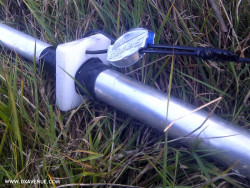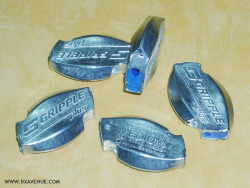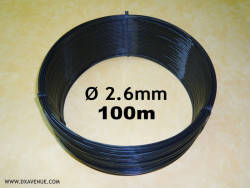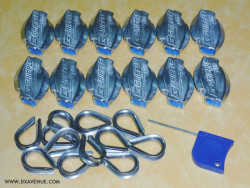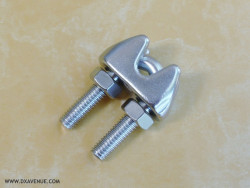In respect of insulated guying of antennas, the usual cordage (polyproylene etc) has the annoying tendancy to succumb to changes resulting from climatic conditions (rain, wind, sun, ice) and their lifetime is limited. For an equal result cordage made from aramide fibres (Kevlar®, Twaron® etc) are very much dearer and their lifetime is rarely indicated.
Deltex® line which we offer you is characterised by very little stretching under tension, complete elastic memory,an excellent performance under all climatic conditions (water, sun, ice) between -40°C and +70°C, high breaking strain, very good HF insulation, light weight and a lifetime of more than 25 years!
It is made from a polyester monofilament, black in colour, which was discovered in 1991. It is made in France from first choice high viscosity material (no recycled material). The manufacture results in a breaking strength of 60 daN per mm² which is, for comparison purposes, markedly superior to galvanised steel wire of the same diameter (40 to 48 daN/mm²) or to classic iron wire (15 daN/mm²).
Beware of imitations, especially from abroad where it is not always clear that the anti-UV treatment has been correctly done or that the line is made from recycled material.
Characterisitics
• Diameter of the line: 3 mm
• Colour: Black
• Breaking strain: 400 daN (kgF)
• Weight: 980 g / 100 m
• Volumetric resistivity: > 1 x 10 to the power of 13 Ohms/metre
• Surface resistance: > 1 x 10 to the power of 15 Ohms/metre
• Dielectric rigidity: 60 kV/mm
• Durability : more than 25 years between -40°C and +70°C
Examples of radioamateur applications (3mm line)
• Guying of tubular masts. The 3mm line can be duplicated if necessary, as HERE with a 13m high mast and a 2 element 30m Moxon on top.
• Guying of very tall vertical antennas, as HERE with a quarter wave 160m vertical where the final 14 metres (75mm tube) is guyed at 2 levels with this 3mm line.
• Tensioning heavy and/or long wire antennas.
• Guying of antennas elements or VHF yagi boom.
• Apart from radio use, a clothes-line equally durable, which doesn't stretch and which lasts for more than 20 years will make the lady of the house very happy!
Attaching the guys
• The most economic and most practical method is the Gripple quick clamp which replaces by itself cable clamp and adjuster. See detailed description on our website.
• 4mm double flat cable clamp suits aswell.
• "U" clamps are not advised because they crush the cable too much.
• With a little practice, a knot is the most economic solution. DX Avenue has provided 2 explanatory notices containing many photographs (Tying a securing knot and Making a splice). There are available by clicking on the tab "ATTACHMENTS" above.
Some advice on use from DX Avenue
• On the reel the end to be used is marked by coloured tape. Don't release the reel after cutting the two retaining cable ties. We advise attaching the end of the line temporarily to a fixed point and moving away unrolling at the same time. Once the desired length is cut off secure the reel with adhesive tape around it before releasing. This is simply due to the small diameter of the bobbin for transportation with 100 m or more of line. After being lightly stretched the line should not twist back into a roll.
• To stretch a wire antenna, the line will slide easily around a pulley or a simple shackle.
Which diameter of line to choose (2.6 or 3mm)?
You may be tempted to go for the larger (3mm) "just in case". The 2.6mm diameter is however largely sufficient for the majority of our applications. The difference in breaking strain is only 90 daN and it is easier to tie a knot in the 2.6mm than the 3mm. This line is often used for strongly tensioning long lengths (for example in agriculture or for support for vines). So it can be seen that the mechanical constraints in amateur radio usage such as the guying of verticals (even up to 20m) are not comparable.
Don't hesitate to contact us if you have any queries or questions. We will work together on your project to reach the best solution.
Our Experience
This type of Deltex polyester line has been used here by F2DX as guying or support since 2009:
• 4 verticals of 20m : Four-square 3.5MHz (2.6mm line)
• 4 verticals of 10m : Four-square 7MHz (2.6mm line)
• The final 14 metres (75mm tube) of a quarter wave on 160m (3mm line)
• 13 metre supporting a 2 element 10MHz Moxon (3mm line) as well as the supports for the elements of this antenna (2.6mm line)
• Various wire antennas such as a double dipole for 80/40m (2.6mm line)
For the last three summers and three winters the guying of these antennas has never needed to be touched. The lines are as they were on the day of installation. See you in 25 years!
Currrently many radio amateurs count on its long life and strength and have adopted this monofilament line to guy their vertical and wire antennas and their elements.






